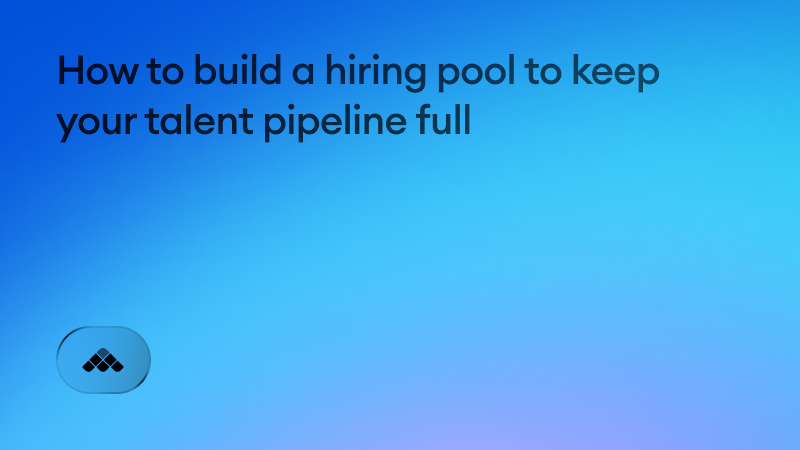Every successful hiring process relies on access to great candidates. But when you’re hiring at scale or filling specialized roles, finding qualified applicants quickly can be a major challenge.
That’s when you’ll be glad you’ve already built a deep talent pool of potential candidates.
A well-managed prospect pool ensures you have pre-qualified, interested candidates, and you don’t have to source each new role from scratch. Whether it’s full of past applicants, sourced prospects, or passive leads, your hiring pool is the backbone of a faster, more efficient recruiting process.
This guide breaks down what a talent pool is, why it’s essential for hiring success, and how to build and maintain one that continuously delivers great candidates.
Key takeaways
- A talent pool is your hiring team’s most valuable resource. It’s an organized collection past applicants, referrals, and sourced prospects that fuels faster, better hiring decisions.
- Nurture your pool like a long-term relationship. By engaging past applicants and keeping data fresh, you’ll reduce hiring time and improve quality of hire.
- AI and automation make talent pools dynamic. Smart tools can automatically refresh data, identify high-potential candidates, and keep engagement active without adding manual work.
What is a talent pool?
Also known as a hiring pool, applicant pool, or candidate database, a talent pool is a centralized collection of people who’ve applied for your roles or expressed interest in working for your company.
This typically includes:
- Active applicants: People currently applying or interviewing for open positions.
- Past candidates: Individuals who previously applied and could be a fit for future roles.
- Sourced prospects: Passive candidates found through networking, LinkedIn, or outreach.
For some organizations, the talent pool represents every candidate who has ever applied. For others, it’s more targeted, focusing on specific job families or frequently recruited roles.
A well-organized talent pool lets recruiters search, filter, and re-engage with candidates quickly. Instead of starting from zero with each new vacancy, hiring teams can tap into a pool of people already familiar with their brand.
Which of course saves time, reduces hiring costs, and improves hiring outcomes.
Why hiring teams actively maintain talent pools
Recruiting moves fast, but finding great talent can take time. Without a well-maintained talent pool, recruiters can find themselves starting from scratch every time a role opens. That means more time spent sourcing, higher costs, and greater pressure to fill roles quickly.
A strong talent pool solves this by giving your team a ready supply of pre-qualified, interested candidates. These individuals may have applied before, been referred, or expressed interest through your careers site or events.
By keeping them engaged and organized, your team can respond to new hiring needs instantly.
The key benefits of maintaining a healthy talent pool include:
- Faster time to hire: Tap into a pool of pre-screened candidates instead of sourcing from scratch.
- Reduced recruiting costs: Cut spending on job boards, ads, and agency fees.
- Higher-quality applicants: Candidates familiar with your brand are more aligned and committed.
- Better candidate experience: Re-engaging with known candidates feels more personal and respectful.
- Improved resilience: Even during hiring freezes or surges, your pipeline stays strong and ready.
Ultimately, talent pools help recruiting teams shift from reactive hiring to proactive workforce planning—a major long-term advantage.
How to build and nurture a thriving talent pool
Creating a talent pool is fairly straightforward. But turning it into a long-term recruiting asset requires structure, communication, and consistent upkeep.
Here are the most effective steps to build and nurture a pool that delivers lasting results:
1. Define the scope
Before building your pool, determine which types of candidates to include. Focus on your most common or high-priority roles—for example, retail associates, sales reps, or nurses.
You can always expand later, but clarity at the start helps you keep data organized and relevant.
2. Centralize candidate data
Bring all applicant information together in one system — ideally within your ATS or a recruiting CRM. This ensures recruiters across departments can search and access the same candidate data, preventing duplication and lost opportunities.
A company might automatically sync all job applicants into segmented CRM folders for “past hires,” “silver medalists,” and “prospects.”
3. Segment your pool
A single, massive list isn’t useful unless it’s structured. Segment candidates based on job type, skill set, location, or experience level. This lets recruiters target outreach precisely.
And crucially, it makes it easy to launch targeted campaigns when openings arise.
4. Stay in touch
The best recruiters treat their talent pool like a community, not a spreadsheet. Send periodic updates, share upcoming openings, and highlight company milestones. This keeps your employer brand top of mind and reminds candidates why they were interested in you in the first place.
A quarterly newsletter or a short update after major company news is often enough to keep engagement alive without overwhelming inboxes.
5. Re-engage past applicants
Some of your best future hires are those who made it near the end of your process before. Reach out to “silver medalists” who impressed but weren’t selected when similar roles come open.
This saves sourcing time and gives strong candidates a second chance at the right fit. Automated reminders or tagged profiles in your ATS make this easy to manage at scale.
6. Measure engagement
Track metrics like open rates, response rates, and reapplication numbers to gauge how well your communication efforts are working. Use this data to refine how often you reach out, and what kind of content resonates.
For example, if candidates engage more with learning and culture content than job postings, shift your messaging to focus on those themes.
When you take the time to organize, segment, and nurture your hiring pool, you gain a sustainable advantage that speeds up hiring and strengthens candidate relationships long term.
How AI sourcing and automation fills your pipeline
Even the best talent pool loses value without consistent upkeep. Candidate information becomes outdated, engagement drops, and top prospects move on. That’s why the most effective recruiting teams rely on AI and automation to keep their talent pools fresh, accurate, and full of relevant candidates.
AI-powered sourcing tools scan the web, social platforms, and professional networks to identify new talent that matches your hiring criteria. And while that’s clearly helpful for overall volume, the impact on quality of hire is even greater. When you’re not limited by time, search scope, or even sleep, your chances of finding the one go way up.
Then they automatically add these prospects to your pool. Every candidate stays updated, tagged, and nurtured without adding manual work for recruiters.
How automation improves your talent pool:
- Smarter targeting: Algorithms find the needles in the haystack—candidates most likely to fit your roles and respond with interest.
- Continuous updates: AI refreshes candidate profiles, ensuring your data stays current.
- Automated engagement: Personalized messages and follow-ups can be sent based on candidate behavior or timelines.
- Data-driven prioritization: Recruiters see at a glance which candidates are most qualified or active, allowing for faster outreach.
The result is a self-sustaining, high-quality pool of engaged talent just waiting for your next role to go live.
How Metaview makes sourcing more dynamic
Metaview’s AI-driven platform helps recruiters go beyond simply building a talent pool. You can easily expand, enrich, and activate it automatically. With tools designed to find the best candidates and keep them engaged, Metaview turns passive databases into proactive hiring engines.
With Metaview, you can:
- Automatically fill your pipeline: Metaview’s AI Sourcing Agents continuously search professional networks and databases to identify candidates who fit your roles. These agents build your hiring pipeline automatically from only a simple prompt or job description, so you can focus on interviewing and relationships rather than scrolling.
- Capture insights from every interview: Every interview transcript is analyzed by AI to uncover patterns in what your best hires share. That includes skills, communication styles, and motivations. These insights refine your candidate sourcing strategy over time.
- Enrich and personalize follow-ups: Use AI-generated summaries and context to send thoughtful, personalized messages to candidates post-interview. Keep engagement high without additional workload.
- Spot sourcing trends and skill gaps: Metaview highlights which roles, regions, or candidate profiles are consistently performing best, so recruiters can focus sourcing efforts where they’ll make the biggest impact.
- Integrate seamlessly with your ATS: All candidate data, insights, and engagement history flow automatically into your applicant tracking system. Every lead and lesson is captured.
Metaview keeps your talent pool organized, enriched, and alive. With automated sourcing, personalized insights, and seamless collaboration, you focus on what really matters: connecting with the right people faster.
Build a thriving hiring pool automatically
A well-managed talent pool is more than a database. It’s a living system that powers faster, smarter, and more consistent hiring. When recruiters can access engaged, pre-qualified candidates instantly, hiring transforms from a reactive scramble into a proactive, strategic process.
The key is automation. AI tools like Metaview keep your hiring pipeline full and updated, without endless effort. Combine that with insights from real interview data, and you’ll always know what makes a great hire for your team.
By building and nurturing your pool with the right balance of technology and human connection, you’ll reduce time to hire, improve candidate quality, and ensure your team is always ready for what’s next.
Try Metaview for free and see how AI-powered sourcing and interview intelligence can help you build a hiring pool that never runs dry.

Hiring pool FAQs
1. What’s the difference between a hiring pool and a hiring pipeline?
A hiring pool is a broad collection of people who’ve shown interest in your company or applied for roles. A hiring pipeline is a more refined subset of that pool: candidates actively being considered for upcoming or current openings.
2. How often should I update or refresh my talent pool?
Ideally, review your pool every three to six months. Use AI or automation to update candidate data, identify inactive profiles, and re-engage prospects who may now be open to opportunities.
3. Can AI really handle sourcing effectively?
Yes. Modern tools like Metaview’s AI Sourcing can analyze job descriptions or prompts to identify qualified candidates across networks automatically. They continuously search, refresh, and deliver potential matches, saving recruiters hours of manual work.
"I just got off a video intake meeting with a new client where Metaview was also attending. And a few minutes later I get an email with already sourced candidates that might be a good fit for said roles. Purely based on the conversation I had from the hiring manager! Metaview...for AI's sake...stop blowing my mind!" - Nick Roman, Tech Recruiter/Founder, HNT Talent
4. How can small recruiting teams maintain a large talent pool?
Start by centralizing all candidate data in your ATS and using automation to handle repetitive communication. Even basic segmentation and automated email sequences can keep your pool engaged without requiring extra headcount.
5. How does Metaview improve the quality of my hiring pool?
Metaview goes beyond sourcing. It captures and analyzes interview data to reveal what successful hires have in common. That information helps recruiters refine sourcing strategies, personalize outreach, and focus their pool-building on the candidates most likely to succeed.


